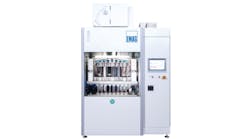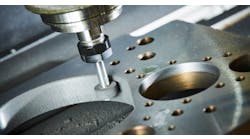Many machine shops understandably try to recover the expensive acquisition cost of live-tool machines by saving on options that might seem unnecessary at the time of purchase. One feature that shops might forego is “through-spindle internal cooling”; flood cooling may seem an acceptable, cost-saving alternative.
Most shops would acknowledge though that external cooling (in which coolant is sprayed at the cutting area through a nozzle positioned three to six inches away from the cutting point) is inherently inefficient. Unless the operator has excellent aim, the coolant stream could miss the target entirely, resulting in poor chip evacuation, high tool temperature, and an overheated cutting zone. Even an optimal set-up still results in coolant spray and splatter.
For drilling or deep-pocket machining, flood cooling is particularly ineffective as the stream fails to reach the cutting zone once the tool enters deeper into the workpiece. Then, additional peak cycles are required to evacuate chips and cool the tool head, which makes for longer overall part-cycle times.
In through-spindle internal coolant systems, coolant streams through the tool tip directly at the cutting zone, efficiently evacuating chips and cooling the area without additional peak cycles. And that is a much more effective method of machining.
With a non-through-spindle coolant system, shops are probably programming extra blow-off cycles to get chips out of the way, losing productivity, and again extending part-cycle times. If a programmed cycle is cooling off a cutting tool or evacuating chips, the machine is not making chips, and that’s not the most efficient way to use a machine.
On the downside, through-spindle coolant systems are expensive to buy and maintain. Coolant-through tool machines cost approximately twice as much as an external flood machine. Note too, through-spindle cooling systems carry a substantial annual maintenance bill – somewhere near 20 to 30% of the original purchase price – to cover the cost of opening, regreasing, and inspecting seals in the tool head.
Retrofitting to through-spindle cooling. In many cases, once a shop gets its non-through-spindle coolant machine up and running, the operators begin questioning whether or not there was a better option. At that moment, being able to convert tools to coolant-through by installing something as simple as a reCool unit becomes extremely appealing.
For about half the price of an original through-spindle coolant option, the REGO-FIX reCool system will convert an external flood coolant machine into an internal cooling system, and eliminate the annual maintenance requirement.
Suitable for emulsion and oil coolants on live, static, and Swiss automatic machines, the reCool retrofit is completed in a matter of minutes. Users simply install external fluid fittings, coolant hose, and a special reCool nut fitted either with a sealing disk or coolant flush disk that directs coolant through or, if desired, to the periphery of the cutting tool. Peripheral cooling with the coolant flush disk directs coolant to the cutting zone along the tool shank, and it’s suitable for moderate cavities. The sealing disk conducts coolant through the tool for maximum lubrication and cooling of the cutting edge, providing the best surface quality for deep cavities.
Any standard ER collet (DIN 6499 / ISO 15488) will work with the reCool system, which accommodates sizes from ER 11 through ER 40. Originally configured for stationary collet holders with external fine threads in static holders and ER and ERM threads in driven tools and turning machines, adapters are available to convert to internal threading on static machines and external threading for driven tooling.
The system handles cutting speeds up to 12,000 rpm on driven machines and delivers coolant pressure of 100 bar (1,450 psi) or 150 bar (2,175 psi) with an optional high-pressure hose. While the system is extremely versatile and adaptable, it should be noted that reCool cannot be used with sealed collets in either static or live tooling configurations.
Once the sealed reCool unit is installed, shops will begin to benefit from both schemes: the life and maintenance-free longevity of a non-through-spindle cooling system and the performance of internal cooling. Tool life is increased, surface finishes are improved, and the overall machining process is streamlined.
Non-cutting cycles for chip evacuation and tool cooling are eliminated, thereby reducing work hardening of the workpiece. For some manufacturers, removing those non-cutting cycles allows them to machine their parts in a single pass, which results in shorter overall lead times. Additionally, set-ups are made more efficient by not having to aim the coolant flow, and machine downtime is reduced by longer tool wear that requires less frequent changes.






